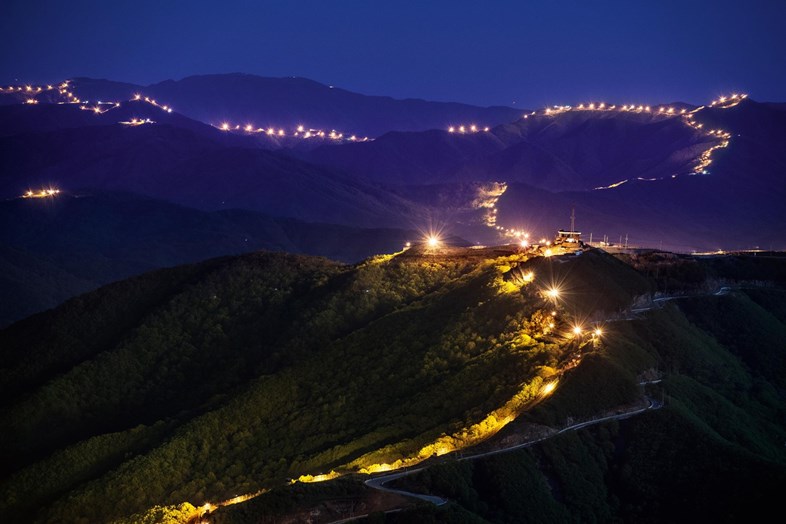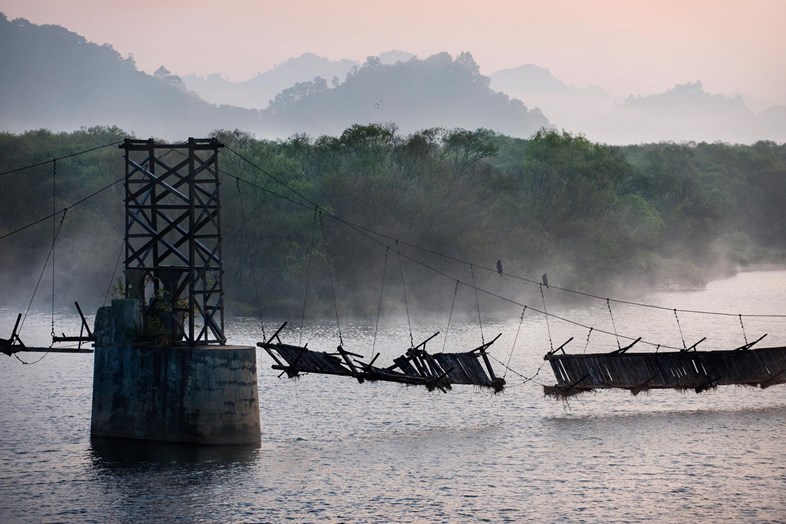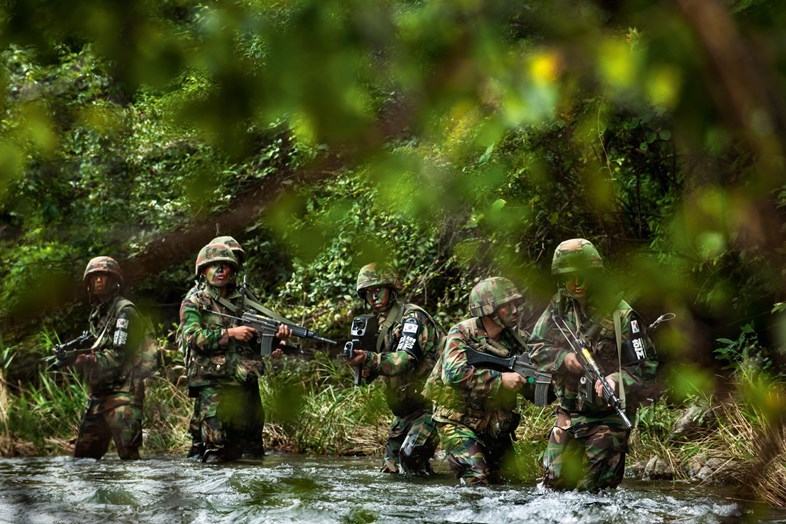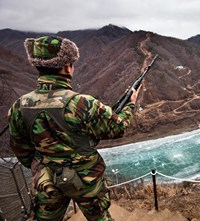Park Jongwoo spent two years documenting the Korean Demilitarised Zone or ‘DMZ’ – here he shares some of his experiences, and some of his incredible photographs
- TextTed Stansfield
It’s hard to believe that just one hour’s car ride from Seoul – South Korea’s bustling, cosmopolitan capital – lies the the Korean Demilitarized Zone or ‘DMZ’, a 160-mile-long strip of land that has served as a buffer between the capitalist South and the communist North since the end of the Korean War in 1953. Heavily patrolled on both sides and strewn with landmines, it’s one of the most hostile and politically tense places on the planet. And, from a foreigner’s perspective, it’s feeling all the more tense given North Korea’s recent missile tests and the current US President’s lack of diplomacy and his promises to respond to the country’s nuclear threats with “fire and fury”.
However for many Korean documentary photographers, the DMZ represents a golden chalice. Park Jongwoo is one such photographer and, in 2010, he was presented with the opportunity to document the region and subsequently spent the next two years taking pictures there. The photographs he produced are stunning and a rare glimpse inside this extraordinary place; one that despite its history of violence, has a sense of peace and silence. Now, these images have been published in a new book titled DMZ, published by Steidl. Alongside a preview of this book, which is out now, Park recounts some of his fascinating experiences from inside the DMZ.
ANOTHER MAN: How did you begin photographing inside the DMZ?
PARK JONGWOO: As a photographer from the only divided nation in the world, it was a dream for me – as it would have been to any other Korean documentary photographer or photo-journalist – to document the DMZ, even though it’s a restricted area that prohibits civilians from photographing the place, or even entering it. But then, in 2010, on the 60th anniversary of the Korean War, the Korean Ministry of National Defense decided to make the first photographic record of the DMZ ever, and proposed the project to me. Of course, I said yes.
The original plan was for it to be a year-long shoot. Much of the DMZ had been inhabited; for a long time, people had lived in the fields, the valleys and the mountain slopes, cultivating the farmlands. It was the war which brought the symbiotic relationship between humans and nature to an end. The war, which broke out on June 25, 1950, was over 37 months later, but it left the forests and villages completely destroyed. The inhabitants were driven out, and the animals of the forests were killed. Over the next 60 years, the last vestiges of the villages and their inhabitants have gradually disappeared, returning the land to its natural state. There is hardly anywhere else in the world like this place, where time has gone backwards. I wanted to record all of these things myself.
AM: How did you find the experience?
PJ: Each time before entering inside the DMZ I had to get permission from five different authorities: the Military Armistice Commission of the UN Command, the Korean Ministry of National Defense, the Joint Chief of Staffs of Korea, the Army Headquarters, and the local army divisions. Every visit was planned months in advance and to the very last detail; we weren’t permitted to alter the agreed schedule for any reason, even bad weather. The original plan was to visit all the South Korean GPs (Guard Posts) inside the DMZ (there are over 100 of them in total), but on 26 March, 2010, after only ten visits, the ROKS Cheonan sunk. The sinking of the South Korean naval corvette lead to increased tension between the South and North. Entering into the DMZ was disallowed. From then on, I had to do my work along the Southern Limit Line, which is just outside of DMZ.
To enter the DMZ, you need to wear a bombproof helmet, a bulletproof jacket and a press armband, as required by military authorities. Also, as it’s mostly a minefield outside the GPs, you need to stay inside the ‘safe’ area, where landmines have been safely disposed of. There is no actual ‘border,’ like a barbed wire fence, between the South and North inside the DMZ. You can run into North Korean patrols any time, which is why you have to be accompanied with South Korean guards at all times when you’re outside the GPs. Some spots are even within firing range of the North Korean soldiers. There’s no time to take pictures there.

AM: What is it like inside the DMZ?
PJ: On the day of shooting, I’d arrive at a checkpoint of the Civilian Control Line to meet the public relations officer of the relevant army division. Then I’d be guided to a GP where I’d be provided with safety education, a bombproof helmet and a bulletproof jacket. Then the company commander of search squadron would lead me to a jeep which is guarded at the front and back by vehicles with soldiers on board. This jeep, which would take me to the GPs, would carry a blue flag according to the ceasefire agreement. Generally there would be three layers of barbed fences set around the GPs and to take pictures outside the GP I had to walk out with a platoon of troops in front and back of me.
The DMZ was originally meant to be four kilometres wide according to the armistice agreement, but as both sides set up additional fences in front of the original fences, it became narrower and narrower. At some points it’s not even two kilometres wide, and you can now look down from the rooftop of some GPs and seen North Korean GP only several hundreds metres away: you could have talked to them if you’d shouted. And it’s too narrow a space for wild animals to live. One of the biggest problems is that the minefield is a lot broader and wider than anyone would imagine it to be. It was all minefields outside the GPs except the few search paths. It would take so long to remove all these landmines later.

AM: What do you think people would be surprised to know about the area?
PJ: Many people think there’s a tense atmosphere in the DMZ, but it’s actually surprisingly peaceful and silent: in the daytime the soldiers are usually sleeping in the post. But there are a lot more landmines than you’d imagine.
AM: What do you hope people take from this book you have created?
PJ: It’s been 65 years since the armistice in 1953. The majority of Koreans have already forgotten the war. Seoul the capital city of South Korea is now just like any other cosmopolitan city and people are living their busy lives, just like anywhere in the world. But just a one-hour car ride from that city, there are heavily armed soldiers of the South and North confronting each other. I hope people realise that the war is not over, that it’s still going on.

Are you concerned about North Korea’s nuclear threat or the prospect of violence?
I am not concerned about that. Many foreigners don’t understand North Korea’s provoking acts and their unpredictable leader’s acts. However, what I really saw myself inside DMZ was quite different from what I had been seeing on the news. The North Korean GPs are mostly underground facilities and there’s no way of finding out what’s in there, and what weapons they actually have. But still, you could guess from the appearance. The majority of the North Korean GPs are old and shabby, just wide enough for three or four soldiers to stand, which is completely different from the huge and modern GPs of the South Korean army.
In the early morning you could see the North Korean soldiers tired from last night’s guard nodding off leaning against the wall, or trying to get rid of head lice. It’s hard to imagine them fighting a war properly. Or you can see them raising crops outside the GPs, due to their insufficient food supplies. The farming villages in North Korea don’t seem that different. There are so many shabby houses and cow-wagons still on the road; they look like 1970s villages. What you see on TV – their capital city Pyongyang which is lead by few political elites – is not like what you see in the DMZ at all. It is hard to predict, even after accomplishing this project, what it would be like from now on because the South and North are completely different. But in my opinion, North Korea has no ability to use their nuclear power.
DMZ: Demilitarized Zone of Korea is out now and available to purchase here.















